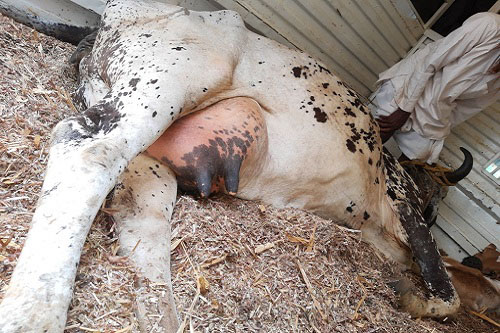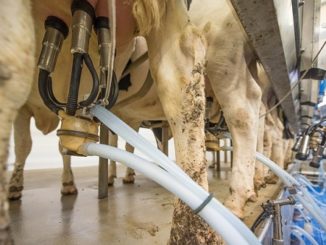Dairy animals are reared for the purpose of milk or calf production. Mastitis have been documented as the most costly disease throughout the world, as it directly affects milk yield changes milk composition, shortens the productive life of affected cows, increases veterinary cost.
Mastitis is persistent inflammatory condition of the mammary tissue (intramammary) which may be caused by physical trauma or infection causing microbes. The causative bacteria are Gram positive or negative which can cause contagious mastitis i.e. Streptococcus agalactiae, Corynaebacterium bovis, Staphylococcus aureus Mycoplasma spp. While environmental mastitis can be caused by Escherichia coli and Enterococcus spp. Or coagulase-negative Streptococcus uberis Staphylococcus spp.
In a study conducted in central region of India the economic losses caused due to mastitis were quantified and it was found that in loss monetary terms was approximately Rs.1390 per lactation, among which around 49% was direct loss of value from milk and 37% was of veterinary expenses. The cost of treating an animal was estimated to be Rs. 509 which includes cost of medicine (31.10%) and other services (5.47%). So overall it is costly disease for a farmer or dairy industry.

Types of Mastitis
Epidemiologically mastitis can be contagious and environmental mastitis. While on the basis of degree of inflammation Mastitis can be classified into three type’s namely clinical, sub-clinical, and chronic mastitis. Clinical mastitis shows the presence of signs of inflammation in udder and can be easily detected as the visible signs are present in this case. Milk production decreases drastically along with the change in color and composition of milk. Sub clinical mastitis usually gets ignored as there are no marked sign or symptoms. The udder and milk looks normal. In this type also milk production gets decreased and is considered as a challenge in dairy industry and it is mostly associated causing financial losses in the herd than clinical ones because of its poor detection. Chronic mastitis lasts for longer duration with inflammation.
Signs/ symptoms of Mastitis
Clinical mastitis can be detected visually, some sign and symptoms are as follows
- Milk contains clots or is discolored, watery or flaky, bloody milk.
- Swelling, redness, heat, hardness and pain in udder.
- Reduction in milk production.
- Elevated body temperature
- Lack of appetite.
- Reduced mobility by animal.
Sub clinical mastitis cannot be detected visually, there is slight decrease in milk yield, the udder and milk looks normal but when milk of affected cows is checked, there is elevated value of Somatic cell count in the milk.
In chronic form
- Presence of hard lumps in udder.
- Atrophy of affected udder.
- Fibrosis of udder leading to total loss of milk production.
The chances of recovery in chronically affected quarters are very low once atrophy/fibrosis has occurred.
Pre disposing factors
Mastitis is a multifactorial condition as it has many predisposing factors as listed below
1) Animal Factor
- Genetics and breed- it has been found that genetic factor and breed plays role in resistance or susceptibility of animal towards mastitis. For example Jersey breed has less susceptibility than Holstein Friesian.
- Age of Animal- older animals are more susceptible to carry infections, because of the permanently partially-open or wider teat canal as a results of frequent milking.
- Mammary Structure- funnel-shaped teats or pendular-shaped udder and blind quarters after calving are at greater risk of sub-clinical mastitis.
- Immune status- the animals with suppressed immune status are more prone to get infected.
2) Nutrition
It can also play a role in acquiring mastitis risk. When in negative energy balance, especially in transition state, animals are more susceptible to infection.
3) Environment
- Milking pen environment – the hygienic condition of the milking pen/parlor is an important pre disposing factor.
- Hygienic condition of barn where animal is staying.
- Improperly working milking machine may also lead to mammary infection.
4) Factors associated with animal handler
- Hygiene of handler at the time of milking
- If hand milking is performed, over milking or under milking can also cause damage to udder health.
Prevention Strategies
Rather than calling it as a disease, it can be said as the managemental condition, as it can be prevented by following steps as mentioned below.
- Proper hygiene- Whether it is milker’s / animal handler’s hygiene or animal hygiene, proper care should be taken care off.
- If hand milking is done, proper care should be taken that the udder is washed properly before milking and after milking teat should be dipped in proven effective teat dips Teat canal remains open for approximately about 2 hrs after milking, so immediately after milking animal should be prevented from sitting to avoid direct entry of pathogen.
- Before mixing newly purchased animals with herd, they should be tested first for sub clinical mastitis and treatment should be done if found positive.
- The infected animals should be milked at the last.
- Fore-strip milk from each quarter. This practice should be followed before attaching the milking unit to check for clinical infection. Fore-stripping stimulates oxytocin, which in turn encourages milk let-down and increases milk flow rate. It may be done before the application of teat dip.
- Milking process should be monitored whether use of milking machines is proper, whether the fit of machine is harming the udder etc.
- The infected animals can be treated by
-
- Giving intramammary infusions of antibiotics under veterinary supervision to clinically affected cows and maintaining their proper record.
- Treating cows at drying off , use of antimicrobial dry cow therapy (DCT) provides an opportunity to eliminate existing intra mammary infection and provides protection against new infection during the early dry period.
- Cull cows with repeated clinical mastitis condition.
- Various vaccines have been used for mastitis, but many of them are of limited protection against coliform infections.
Presently mastitis can be controlled by proper monitoring of cow health, on teat disinfection, antibiotic therapy, and culling of chronically infected cows. There is no single effective vaccine against any mastitis pathogen.






Our researched med can stop Mastitis among mammals altogether. We are a stratup and have developed confirmatory treatment to stop Mastitis in animals. We wish to share our research/med with interested institutions/people/farmers to further establish our claim. The med is 100% safe for animals and humans and contains herbs, which can be established.